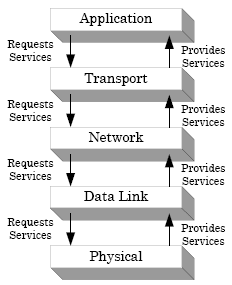TCP/IP
Contents
[hide]What is a protocol
A protocol is a set of rules, using protocols will allow 2 devices using the same protocol to communicate effectively. Many protocols are used, but they all perform a specific task.
TCP/IP Stack
TCP/IP stands for Transmission Control Protocol / Internet Protocol, it defines how data packets are transmitted over a network. TCP is used to break up the data into packets, it will keep track of the packets, and it will re-assemble the packets. IP is used to delivery each individual packet.
TCP/IP is a stack of protocols because it includes several layers and each layer uses a number of different protocols. Each layer will wrap the data passed to it, with the appropriate information for the layer. When received the layers are unwrapped by each layer. The physical layer is the actual network devices.
Application layer
The application layer sits at the top of the stack and uses protocols relating to the application being used to transmit the data over a network. Incoming and outgoing data are converted from one presentation format to another, the original data and the appropriate format for the application layer protocol.
Application layer protocols include: HTTP, FTP, SSH, POP3, SMTP etc.
For example the data could be:
The quick brown foxes jumps over the lazy dog
Transport layer
The transport layer uses TCP to establish an end-to-end connection with the recipient computer. The data is then split into packets and labelled with the packet number and the port number through which the packet should route. This ensures it is handled by the correct application.
If any packets go astray during the connection the transport layer will request for them to be re-transmitted.
The above example could be broken into packets:
| Packet 1 of 3 | Packet 2 of 3 | Packet 3 of 3 |
|---|---|---|
| The quick brown | fox jumps over | the lazy dog |
| Port 80 | Port 80 | Port 80 |
Network layer
Link layer
Ports
An addressable location on a network that links to a process or application. A port number is a way to identify a specific process to which an Internet or other network message is to be forwarded when it arrives at a server. The port number is a 16 bit integer, The well-known ports cover the range of possible port numbers from 0 through 1023. The registered ports are numbered from 1024 through 49151. The remaining ports, referred to as dynamic ports or private ports, are numbered from 49152 through 65535.
Why we need them
When an application communicates over a certain port, it expects a specific type of connection with another system or application. Specifying port numbers ensure two systems communicate correctly. While it is possible for two systems to communicate over any given port, it can cause interference if other data is being transmitted on the same port. The application will also listen to the port for incoming data.
Well known port numbers
Well Known port numbers are important because if everyone sticks to the numbers you can connect without any issues. If you change the port number of your webserver to 85 for example, nobody would be able to connect unless they knew to use 85 instead of 80.
The common port numbers are:
- 21 FTP
- 22 SSH
- 23 Telnet
- 25 SMTP
- 80 HTTP
- 110 POP3
- 443 HTTPS
Socket
A socket is an endpoint in a communication, it identifies an application and device. It is the IP address with a Port number, so this would be a socket:
192.168.1.150 : 80
Where as, this is just an IP:
192.168.1.150
Protocols
The most common are:
HTTP
Hyper Text Transfer Protocol, most often found at the beginning of URLs, is used to transfer an user to a web address that is specified via the domain. This uses port 80,
HTTPS
A verified, secure version of HTTP. This ensures the user that the website they are on is safe and well protected. This uses port 443.
FTP
File Transfer Protocol. This allows you to download / upload files to a server, for example you would upload your websites pages to your webserver using FTP. FTP uses port 21.
SSH
Secure Shell protocol. This protocol allows remote access to a computer, this could be used to perform admin tasks on a server. You will only have command line access to the computer. SSH is also designed for operating securely over an unsecure network. SSH uses port 22, this was deliberately chosen because it was created to potentially use instead of Telnet or FTP.
TELNET
Allows a user to log into a remote computer over the interlinking network. Similar to but predates SSH. Telnet uses port 23.
POP3
Post Office Protocol, version 3. Used to receive incoming emails from an email server. This uses port 110.
SMTP
Simple Mail Transfer Protocol. This is used to send emails, it uses port 25.
